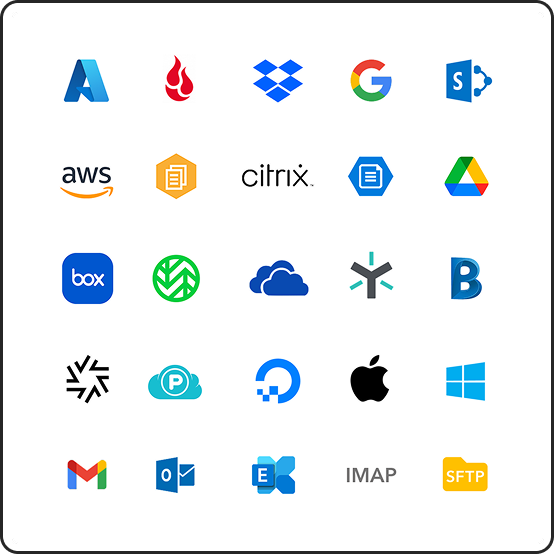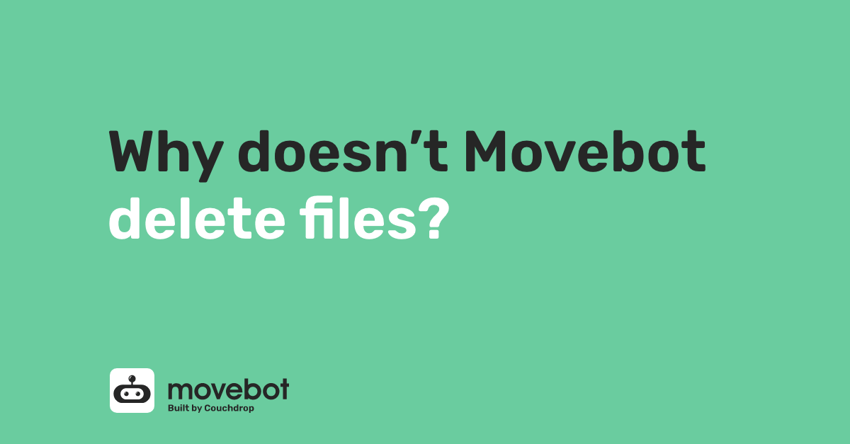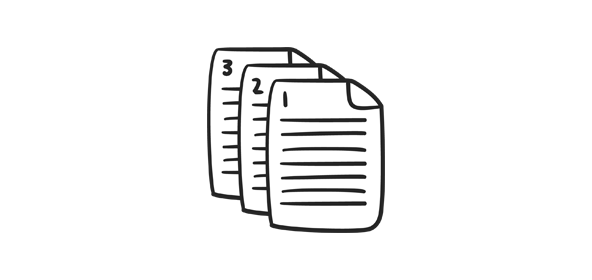We’ve all done it. Deleted a file by accident. Saved something after making a stupid mistake. Overwritten our main save file with a save state a frame before being sniped. Depending on how critical the file was, you can be left with a lot more trouble than having to redo a few hours of gameplay. You can put your company at risk, face fines, or worse.
We don't delete files at Movebot.
Our goal is to make data moving simple. One way we do this is by not deleting files. At first glance, this might seem like a massive oversight. Deleted files poof back into existence. They appear at the destination like that guy who keeps crashing BBQ parties and eating all the filets.
But there’s an important reason we don’t delete files. It’s a major security concern and would invalidate one of our most important tenets: we don’t store your data, and you have full control of it.
Movebot is a bit of a misnomer
While we're called Movebot, a more accurate name might be "Copybot". (Which is a terrible name that sounds like something Freshmen would use to plagiarize homework). Movebot doesn't actually move anything like a cut-and-paste operation. Instead, what it does is make a copy of everything on the source, transform the data to fit the requirements of the destination (based on the settings you choose of course), and put that modified copy into the destination.
The original files are never touched, only copied. While this might seem annoying, it actually offers a lot of advantages. One is that there's no downtime required for migrations. Users can continue working in the source even while the migration is running and it won't affect the performance, cause errors, nothing like that. Instead, the organization can continue business as usual and then use Movebot's delta migrations to pull across any changes.
Another advantage is that there isn't going to be some unknown "An error has occurred" in the middle of a transfer that causes the files to be lost or corrupted. In a move operation, an error could be extremely serious if the right precautions weren't taken. Files could be lost in the wrong circumstances, and if there isn't a way to restore them, they'd be gone for good.
Of course, the only way to restore the files would be if there was a place to restore them from. And if the tool is able to do that, that means the tool has access to your data, which brings its own set of risks and privacy concerns. Movebot doesn't store your data, and you have full control over what happens to it. Movebot simply copies files between your existing storage in a fast and efficient way.
Simply a data migration tool
Movebot is a data migration tool, but you're the driver. And you don't need to sort complex licenses or go through training programs to use it.
Movebot is simply the software that allows an agent to get the job done. Think of it as a large truck from a moving company. You pack up the truck with all of your belongings the way that you want to. Then, when you’re happy with everything, you lock up the back and pocket the key (Okay, so it’s a weird moving company). Then you start the ignition and trust the truck is robust enough to make sure your possessions arrive safely.
The truck never sees what you packed. The truck doesn't know anything about what's inside and won't do anything about it, unless it gains some kind of Mater-esque sentience. Your data is safe and secure, and can't be taken or removed. With Movebot, you’re the driver, the only one with the key, and the truck is simply a vehicle to get your things across.
Contrast that to if the driver has the key to your belongings and can change things to their whim. Most likely, your items will still arrive safely. But, there’s the chance the driver can open up the back and decide that the box labeled Grandma’s Ashes can be dumped at the side of the road. If the software has access to alter files, there’s the possibility that important content gets lost.
Or, in a worst-case scenario, you notice that your new cloud platform seems to have the files, so you (or an ambitious Junior) delete all the ones in your old account while the migration is at 99.99% complete. Seeing that your most recent action was to delete the files, the software might decide that’s what you intended to do. And poof. No more data on either system.
We avoid deletions altogether so you can stay in control. If you want to keep the files in the source temporarily, then you're good to go. And if you want to delete them, you can do that, again having full control of how and when you delete them.
Just PAC and Move - Simple data migrations with Movebot
For most organizations, the data migration will be quick and painless. Most migrations are done within a day.
But what if you’re a large organization with a massive amount of data? What if you have over 10,000 users and a few Petabytes worth of data to shift? Even with Movebot’s impressive speeds, a transfer of this size is going to take a bit to finish. That doesn't mean it will be difficult.
With Movebot, migrations are done in 3 easy steps, no matter how much data there is. All you have to do is go through the stages of Plan, Advance, Cutover to PAC and be ready to get moving.
Plan
The first step of a migration is to Plan. Choose what files to move and where you want to move them to. Have files you don't need? You don't have to move them and then manually delete them later; simply avoid moving them in the first place. Use Movebot's built-in filtering to create criteria to exclude files during project setup, or map users and directories you need while leaving out ones you don't.
You can also run a discovery scan to check that everything will migrate as you expect. Sure, a discovery scan will add time to the job but as Scar says “Be Prepared”. If you have a larger job or are moving millions of files, running a scan before the migration helps you be prepared for sensational news instead of wearing a vacant expression wondering why some files didn’t come through as expected.
The scan searches for potential issues and flags them so you can decide how to proceed. It also shows you how much data you actually have–not double counting shared files for instance–and gives an accurate picture of what to expect. And it’s free, so why not?
Once you've planned everything you want to move, it's time to Advance to step 2.
Advance
One benefit of Movebot is that you don't have to do a big bang migration and shift everything at the source in one giant job. If you have a PB of data to transfer, you can (and should) break it up into smaller jobs instead of trying to move the entire amount at once. Having more jobs takes more planning and oversight, but you reduce the risk of having to restart a major transfer in the rare case something goes wrong.
Continuing with this careful, measured approach throughout the migration can make it practically background noise that most users won’t notice. Plan out which files to transfer at which times and a lot of the headache is already gone.
You can run multiple transfers at the same time too, so break down your migration as much as you want to. This can help manage the files that you'll want to delete as well. Leave out entire folders or users if you don't want them.
When the bulk of the files are moved, you're now onto step 3, Cutover.
Cutover
When you start a migration with Movebot, it takes the data at that moment in time and makes a copy of it in the new platform. Think of it like a photo. Movebot takes a snapshot and then replicates it so you have it at the new location.
The problem? Your organization may have made changes since then. If you have a petabyte of data, it’s not realistic to have employees stop using cloud storage for a few weeks while the data transfers. Fortunately, delta migrations make quick work of this issue, and are a main component of the final stage, Cutover.
So what exactly is a delta migration? It’s a migration of only the data that changed since the last transfer.
First, you copy all of the data over i.e. take the snapshot. Only that snapshot won’t pass a game of Spot the Difference because people have altered the original since the data started moving. To solve this, a delta migration then reads both sides, compares the two instances, then finds any files that changed in the source and adds them to the destination. Then you can confidently say they’re the same picture–almost.
Remember that Movebot doesn’t delete any files; the deleted files are already at the destination and Movebot doesn’t touch the data. So if you did go and delete some files at the source mid-migration, you’d need to delete them again at the destination to make sure they're gone.
However, any updates made to the files will pull over, so if you made 15 versions of the same document while the migration happened, a delta migration will pull over V15 so you don’t have to start from 1 again.
Try Movebot with 50GB free
Movebot is the fastest and simplest data migration tool there is, supporting cloud-to-cloud, on-prem to cloud, and tenant-to-tenant migrations of files and mailboxes. You control how data is moved, what it looks like, and where it goes. We don't delete files because we want you to decide if, how, and when files are erased from your platforms.
To see for yourself how Movebot can help you with fast, secure, and simple data migrations, you can try Movebot for free. Simply sign up and you'll be given 50GB free to try Movebot and run some test migrations with no credit card required. Register for your account now to get started.






